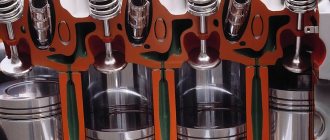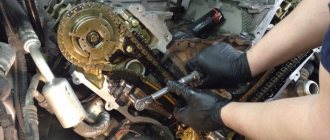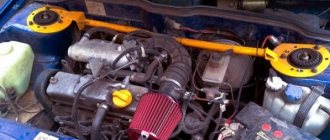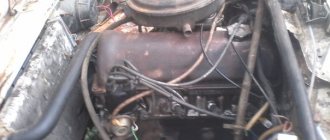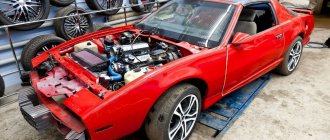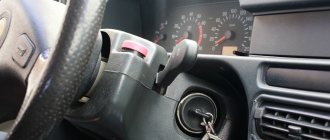The crankshaft does not turn with the starter
The battery is low. The voltage at the terminals of the battery when the consumers are turned off is more than 12 V, but when the starter is turned on, it drops below 6–8 V. In this case, a cracking noise may be heard from under the hood. Charge the battery; if it does not charge, replace it
Reduced battery capacity
The voltage at the battery terminals when the consumers are turned off is below 12 V. When you turn on the starter, a cracking noise may be heard from under the hood. Charge the battery with low current (no more than 1 A); if the capacity is still insufficient, replace the battery
Loud noise when the starter is running
The starter is attached to the engine at an angle, its fastening is loose or the cover on the drive side is broken
Tighten the threaded connections to the specified torque, replace broken parts or the starter assembly
The starter magnet is loose (the armature is touching it)
Disassemble the starter, inspect it, check the alignment of the magnets and the gap between them and the armature
Replace starter
Excessive wear of bearing bushings or armature shaft journals
Replace starter
The crankshaft is turned by the starter, but the engine does not start
Battery is low
The voltage at the battery terminals when the consumers are turned off is below 12 V. When you turn on the starter, a cracking noise may be heard from under the hood
Charge the battery; if it does not charge, replace it
Reduced battery capacity
The voltage at the battery terminals when the consumers are turned off is more than 12 V, but when the starter is turned on, it drops below 6–8 V.
Charge the battery with low current (no more than 1 A); if the capacity is still insufficient, replace the battery
Oxidation of battery terminals, loose fit of wire terminals on battery terminals
When the starter is turned on, the voltage in the on-board network drops sharply (indicator lamps go out), and at the battery terminals it remains almost unchanged (additional voltmeter).
Crimp the terminals, clean the contacts, lubricate them with petroleum jelly
In cold weather, the engine starts easily, but immediately stalls, and only after several starting attempts does it begin to run stably
Carburetor starter faulty
Replace starter
The engine takes a long time to start
(B) The fuel pump does not create the required pressure in the system, fuel filters are clogged, hoses are pinched, fuel lines are deformed, injectors are leaking
Check the pressure in the fuel rail with a pressure gauge - 2.5–3.5 bar (2.5–3.5 kg/cm2), make sure the fuel inlet strainer is clean, inspect the fuel lines
Clean the fuel inlet mesh, replace the filters, eliminate kinks in the hoses, replace the fuel pump that does not provide the required pressure in the system and has low performance. Replace defective injectors
The engine runs rough or stalls at idle
Defective spark plugs: current leakage through cracks in the insulator or carbon deposits on the heat cone, poor contact in the central electrode connection
Candles are checked on a special stand. (The absence of external damage and sparking between the electrodes on the inverted spark plug do not allow us to conclude that it is working)
Replace spark plugs
In cold weather, the engine stalls soon after starting to move, but starts again after a short stop.
An ice plug has formed in the carburetor diffuser (the thermal power element does not work or the heated air supply hose is not connected to the pipe on the exhaust manifold)
Secure the hose with a clamp to the heated air intake pipe. Replace the faulty thermal power element
In hot weather, the engine stops spontaneously and is difficult to start.
Vapor lock in the power system. The fuel drain line into the tank does not work - the tubes and hoses are clogged or pinched, the check valve is faulty
Inspect the fuel lines, blow out the line with a tire pump
Eliminate kinks in hoses, replace deformed tubes, faulty check valve
Causes
General view of engine 21124 16V.
The VAZ 2112 engine has problems with the 16 valve injector for various reasons. To find out the specifics, the motorist needs to know the design features of the power unit, as well as have some vehicle repair skills.
So, VAZ 2112 has 16 valves and the engine is tripping, what could be the reasons for the effect:
- Poor quality fuel.
- Malfunction in fuel supply elements.
- Malfunction of air intake units.
- Malfunction in the ignition system.
- The problem lies in the electronic part of the car.
Solution methods
Before you begin the process of analyzing the causes in more detail, as well as methods for eliminating the malfunction, it is worth understanding that if the car owner is not sure that he can fix the breakdown or does not carry out the correct diagnosis, then it is better not to get involved himself. In this case, it is recommended to contact a professional car service.
Poor quality gasoline
Poor quality fuel is everywhere.
Troubleshooting on a VAZ can primarily occur if low-quality fuel gets into the air-fuel mixture formation system. Thus, most domestic gas stations do not have a very good reputation due to the fact that they sell fuel that does not meet the standards.
So, if gasoline has already entered the system, it most likely clogged the gasoline supply system, and possibly left its mark on the spark plugs. In the worst case, what all car enthusiasts fear is burnout of the valves or piston mechanism.
Therefore, it is better to take the choice of a gas station seriously, since major engine repairs will cost more than saving on good gasoline. It is recommended to overpay a little for fuel, to regularly change fuel cells and carry out constant repairs.
Fuel cells
The process of replacing a clogged fuel filter.
The first place to look for a problem is the fuel supply to the fuel mixture formation system. Thus, clogging of the elements can cause an insufficient amount of fuel to flow into the combustion chambers.
First, you need to check the performance of the fuel pump, or more precisely, an element such as a mesh filter. It is located on the pump itself and often becomes clogged due to the use of low-quality fuel. But, as soon as it is changed, the operation of the power unit returns to normal.
It is recommended to replace the fuel filter along with the filter screen of the gasoline pump, since in this case it becomes clogged and fuel cannot fully pass through the fuel lines. The part is placed under the rear right wheel from the bottom. The element is changed within 30 minutes.
The process of cleaning injectors with your own hands.
The third element, which is responsible for supplying the fuel mixture, is the injectors. Their contamination leads to the fact that the engine begins to stall. In order to check their functionality, it is necessary to remove the elements from the engine. Diagnostic operations are carried out on a special washing stand. If during the inspection it is discovered that there are faulty injectors, then they should be replaced. You should not install faulty parts in the power unit, as this will lead back to tripping and even greater malfunctions than the existing ones.
Air supply
The engine may stall due to problems with the air filter.
Normal air supply is the key to the formation of an air-fuel mixture and a normal combustion process. Thus, a malfunction of one or more air supply elements can lead to the engine starting to choke. These include the air filter and throttle valve.
The air filter element must be changed every 20,000 km, since after this it becomes clogged and becomes unusable. But it is necessary to monitor the condition of the throttle valve, since it is unknown when it will become clogged and begin to cause problems. Typically, motorists clean this unit themselves, using special products or a carburetor cleaner.
content .. 49 50 51 52 ..Lada VAZ-2110 (2111, 2112). The main reasons for engine tripping
— The ignition timing is incorrectly set. — There is an air leak in the vacuum brake booster system. — Faulty spark plugs. It is worth noting that this problem is the most common, since spark plugs need to be changed after driving a car every 20,000 kilometers (this figure depends on the recommendations given by the designers of each car). — Breakdown of the high-voltage wire that goes to the spark plug. — Faulty installed capacitor. — Violation of the tightness of the system in the area of the intake manifold. — Burnout of one of the piston or valve. — Breakage of piston rings, their deformation and wear also lead to this problem. — Incorrect adjustment of the gas distribution valves. — High degree of rocker wear. — Breakdown of the installed cylinder head gasket. — Any type of wear (hardening, breakdown, destruction) of the valve stem seals. — If the carburetor is adjusted incorrectly, the cylinders may also malfunction. — Condition of the installed distributor shaft and rotary plate bearing. — Air filter clogged. — Loss of tightness of the membrane of the vacuum ignition timing regulator. — Use of unsuitable spark plugs (not only the dimensions, but also other parameters of this element are taken into account) for this engine.
Engine troubles
Engine tripping is a definition that should be understood as a malfunction of the internal combustion engine when one or more cylinders do not work partially or completely. To put it another way, the combustion process of the fuel-air mixture in individual cylinders is disrupted, which causes unstable operation of the engine at idle, under load and in transient modes.
Engine trouble manifests itself in the form of increased vibrations of the power unit, and the engine noticeably loses power. Misfires may occur, which are accompanied by strong pops in the exhaust system. The engine can stall either occasionally or constantly, only at idle or under load, cold, hot, etc. Next, we intend to answer the question of what engine tripping is, and also consider the main reasons why the engine begins to trip.
Why does the engine start to stall?
Engine tripping is a violation of the combustion of the mixture in the cylinders, which is accompanied by a clear increase in vibration. Please note that the appearance of internal combustion engine vibrations is not necessarily a tripping, since there are a number of other reasons why the engine vibrates strongly.
Main malfunctions resulting in the engine tripping:
- supply of insufficient or excessive amount of fuel to the cylinder; - supply of insufficient or excess air; - malfunction of the ignition system, early or late ignition; - wear or breakdown of the motor, which is accompanied by a decrease in compression;
In other words, the engine begins to stall as a result of an inappropriate composition of the fuel-air mixture, untimely ignition of the mixture or inability to ignite the charge, as well as violation of the conditions for normal combustion of the mixture as a result of mechanical wear or breakdown of the engine itself. Based on this data, you can narrow your search and the number of systems for diagnosis. The check should begin with the fuel system and injector, then the intake air supply and the ignition system are checked. In some cases, engine stalling may also be the result of a failure of one of the ECM sensors.
Engine troubles: ignition of fuel-air mixture is disrupted
The most common reason that causes the engine to misfire is late or early ignition, as well as a weak spark plug. At the initial stage, you should unscrew the spark plugs for a detailed inspection. If damage to the insulator or other defects is noticeable, then the spark plug should be replaced.
In the case of a damaged insulator, the place of damage is clearly visible, since this area turns black. You should also pay attention to the condition of the central electrode and evaluate the gap of the side electrode. Next you need to check the spark plug wires. An indirect sign indicating this element is the occasional tripping of the engine in conditions of high humidity (rain, dampness, etc.). After the engine warms up and reaches operating temperature, the symptoms may disappear completely.
You should start by inspecting the spark plug cap and the highest voltage wire. These elements have rubber insulation, which tends to dry out and crack over time, as a result of which the wire begins to break through. Also, the high-voltage wire or cap is often damaged during service or repair work in the engine compartment. Let us add that the location of the breakdown may not be visually detectable. In this case, it is better to check this element of the ignition system using one of the available methods. If everything is in order with the spark plugs and wires, then the ignition coil may be the culprit for the engine misfiring. On engines with separate coils for each spark plug, this phenomenon is especially widespread. To check the ignition coil, you need to unscrew the spark plug, apply it to ground and start the engine. Please note that the thread of the candle must tightly touch the mass, the cap must be tightly placed on the candle. Ignoring these rules may result in burnout of the coil or commutator. A good spark with a characteristic crackling sound will indicate the serviceability of the coil; the absence of a spark will indicate the need to replace the coil.
As for the electronic ignition distributor (switch), this element does not break down often. To check, the spark plugs are securely attached to ground, then the caps are connected to them, after which one person turns the engine with the starter, and the other evaluates the strength of the spark on the spark plugs.
Motor tripping: air supply problems
Inadequate or excessive intake air can also cause cylinder misfire. The air supply system may lose its tightness and the engine begins to suck in excess air. The ECU does not take this leak into account, and as a result, the stability of operation is disrupted.
Checking the air system is quite simple. It is necessary to tightly close the inlet pipe next to the air filter, then pump air to create a pressure of about ½ atmosphere, and then look for the leak. If the pressure does not drop, then the system is sealed. The appearance of a hissing sound of escaping air allows you to determine the problem area through which the motor is sucking in excess.
Lack of air often occurs due to a dirty air filter that has lost its capacity. The filter must be removed and the engine performance assessed after removal. There may also be insufficient air if the throttle valve is clogged or there is a problem with this unit. This element requires mandatory cleaning and inspection. It is advisable to do this at every scheduled maintenance in parallel with replacing engine oil, filters, etc. Another reason for the engine tripping may be the TPS, mass air flow sensor or another sensor that sends an incorrect signal to the ECU. In such a situation, the control unit does not know to what degree the damper is actually open, how much air actually entered the engine, etc. Based on incorrect data, the “brains” cannot accurately calculate the optimal composition of the fuel-air mixture in relation to the dynamically changing operating modes of the internal combustion engine.
In this case, you should view the sensor readings and read the errors using a scanner that is connected to the vehicle’s diagnostic connector. Then the values must be compared with the nominal ones. Deviations from the norm in the readings of the air flow meter or throttle position sensor lead to the engine starting to stall.
Troubleshooting in cylinders: faulty power system
When checking the power system, you should pay attention to the following nuances:
-fuel pressure; -air leak;
Fuel pressure directly depends on the serviceability of the electric fuel pump, which on modern injection cars is located in the fuel tank. The device may have a clogged fuel pump filter, or problems may arise with the electric motor of the fuel pump or the power supply to the pump. It is also worth checking the pressure regulator valve in the fuel rail. Low pressure in the fuel supply system is often the cause of tripping.
The next step is to check the injection nozzles. This element tends to become clogged, resulting in reduced throughput, disruption of the spray pattern, etc. Also, failure of the injector itself should not be ruled out. To clean and check the injectors, you can use a washing stand, in which a special washing liquid is pumped through the device and power is supplied. Under such conditions, the operation of an injector on an engine is simulated, performance is assessed, etc.
You can also check and clean the injectors yourself. To do this, liquid (for example, carburetor cleaner) is also pumped through the device. Power is supplied through a simple circuit with a light bulb from the battery terminal. A working injector should not leak when closed. Also, the injector must open in a timely manner when an electrical impulse is applied. It is not allowed for the injector to pour fuel, since the efficiency of subsequent combustion of the charge in the cylinder depends on the quality of the spray.
If the fuel pressure and the injector itself are OK, then you should check the ECU. The control unit itself rarely fails, but it is possible. More often this happens in cases where the factory firmware was changed when installing an LPG or the engine was given software chip tuning. Unprofessional manipulations with fuel maps can lead to the ECU overfilling the fuel and flooding the spark plugs.
Reduced compression in cylinders
A drop in compression indicates engine failure or wear. One or more cylinders are partially or completely inoperative, so fuel and air are delivered, but the mixture is not compressed properly. In this case, normal combustion does not occur. A drop in compression occurs due to burnout of pistons or valves, severe wear of piston rings and other defects in the cylinder head, cylinder head or timing elements.
In this case, it is necessary to measure the compression in the engine, after which the unit is disassembled for detailed diagnostics and repairs. In conclusion, I would like to add that operating an engine with a malfunctioning cylinder is prohibited, since driving with such a malfunction leads to a number of additional problems, which significantly complicates and makes subsequent repairs more expensive.
content .. 49 50 51 52 ..
Conclusion
The causes and methods of eliminating the malfunction of tripping on the VAZ 2112 16 valves are considered. If the problem still cannot be resolved, then it is recommended to contact a car service so that professionals can sort it out. Maybe it's time to replace the valves or rebuild the engine.
AutoNews / Reviews / Tests
Troit Engine VAZ 2112 16 Valves Reasons
What to do if you're having trouble
VAZ-2112 engine 16
valves
Interruptions in engine operation sometimes lead to complete failure. Tripletion is the work of 3 cylinders, which causes a huge number of problems. First, comfort during movement is lost, the power of the unit is reduced, severe excessive consumption of fuel appears, and unprocessed gasoline vapors are felt in the exhaust gases. Let's figure out what prerequisites cause the VAZ-2112 engine, which has 16 valves, to trip.
Consequences of engine tripping
A malfunction of the power unit not only leads to discomfort while driving, but also to more severe dilemmas. The fuel that enters the idle cylinder and does not even burn, flows into the crankcase with oil. The fuel mixture makes the engine oil more watery and loses its characteristics.
If you don’t immediately fix the problem in the engine, then over time the pistons and rings will begin to wear out. The absence of a lubricating film leads to the formation of nicks and nicks on the cylinder walls. Thus, the occurrence of extraneous noise in the engine leads to the need for major repairs.
Possible reasons
Malfunctions in the operation of the power unit are more likely to be caused by defects in one of several systems:
- ignition;
- nutrition;
- Timing belt (in particular valve);
- sensors and bortovik;
- piston group.
The VAZ 2112 16 valve engine is causing problems.
Without checking each accounting software (software), it is impossible to solve the problem. Therefore, start with diagnostics to narrow down your search.
Reasons for unstable operation of the VAZ-2112 at low speeds
General view of the 12-series engine
There are not many reasons that accompany the appearance of the jerking effect at low speeds. We can even say that everything is tied to the fuel supply system to the cylinders. So, it is necessary to identify all the reasons that are associated with the problem on the car:
- The problem is hidden in the fuel system.
- Incorrect throttle operation.
- The crankshaft sensor has failed.
- ECU.
Perhaps the reason for the car jerking is worth looking for here. When all the problems have been identified, it is worth moving on to searching for solutions to the problem.
Checking the ignition system
All car owners begin checking the 1.6-liter VAZ-2112 engine by testing spark plugs. They will help you find a cylinder that is not working according to the full program. For this purpose, you first need to alternately remove the high-voltage wire from each cylinder. When you touch a non-working cylinder, the nature of the power plant will not change.
Next, do a “spark” test to eliminate difficulties with supplying power to its surface. For this purpose, return the wire to the spark, place it on the engine
so that the electrode does not touch it. Crank the starter until sparking appears. Later, look at the candle body and evaluate the signs comprehensively.
- If the spark is very weak, and the spark plug visually has a strong carbon deposit, then the reason for this may be a non-functioning air filter. This causes dust to fall on its surface and mix with oil and fuel.
- If the electrode of the spark plug is intact, and carbon deposits have formed on its body, then there are several circumstances for you: incorrectly adjusted ignition (detonation is advanced), an error in selecting spark plugs, a lean fuel mixture.
- If only the electrode burns out, then the malfunction is hidden in an excessive enrichment of the fuel mixture, an incorrectly selected spark plug, low compression pressure, air filter impermeability, and delayed detonation.
Reason one - spark plugs
I wrote in detail about how to determine faults in car systems using spark plugs
here .
I recommend reading it - it turned out to be useful, judging by your reviews, thank you.
We unscrew the spark plugs one at a time and look at their insulator.
If it is covered with dense carbon deposits, then it is difficult for a spark to penetrate it. The current seeks the path with the least resistance, so the spark will not be between the electrodes, but will “go” along the insulator to the side. Its energy will not be enough to set fire to the air-fuel mixture. This cylinder will not work.
We inspect the external condition of the spark plug insulator.
If there are microcracks, then part of the current will not be converted into a discharge, but will escape through these damages. You need to look at the internal insulator, which is screwed into the cylinder head, and at the external one, onto which the armor wire cap is placed.
Large or small gap between electrodes.
Many people have heard or know that for certain engines, ignition systems and types of fuel used, spark plugs with a certain gap are required. Usually its value is indicated by the manufacturer of engines and cars.
How to check the spark without special devices on the engine
This is an old, “grandfather” method, some people are afraid of it:
- They unscrewed the spark plug;
- They put an armored wire on her;
- They leaned it with the inner body, the metal part, against the engine;
- Turn on the ignition and turn the starter.
We look at the spark when trying to start the engine. If it hits clearly between the electrodes, is bright, and does not move to the side, then the candle is “live”. Screw it into place. Let's move on to another “subject”.
What to do with black carbon
First of all, let's look at the cause of the rich mixture. It is this that is the source of this deposit on the electrodes. Perhaps it appeared as a result of the “dying” of the spark plug, when the fuel stopped igniting normally. This soot was deposited on the electrodes and insulator.
We try to clean the spark plug with sandpaper. We only clean the electrodes themselves; there is no need to touch the insulator. We install it in place, start it and listen to the engine.
What to do with a large or small gap
Many Zhiguli owners know how to adjust it themselves. To do this, you will need a set of probes of different thicknesses, a hammer or pliers.
- Let's find out what interelectrode gap is recommended for your engine. For example, on Zhiguli cars with a contactless ignition system, 0.7-0.8 mm is recommended;
- We take the probes, find the appropriate size and put them between the electrodes of the spark plug;
- If it climbs freely, gently tap the side electrode with a hammer (not a sledgehammer) or pliers. Sometimes it’s enough to press hard and the electrode will give way. We measure again, if it flies by again with a whistle, we bend it again;
- If it doesn’t fit through, bend it over the edge of the side electrode with pliers. It is advisable to do this with a thin screwdriver. We insert it between the electrodes and bend the central one a little.
Troit VAZ 2110 16cl 1.5/REASONS/Troubleshooting
KEY-DOP
In this video you can see how to remove air leaks if the car is shaking
at idle and running.
Inspect the spark plug well; if you find oil in the computer, then you need to adjust the operation of the caps responsible for supplying it. In most cases, this malfunction requires replacement of the valve stem seals. There are no cracks on the spark plug body; if damage occurs, change the spark plug, even if it is visually intact.
Additionally, it is recommended to change high-voltage wires, because microcracks occur in them. Here the spark is weak, but the candle is visually intact. If this element is damaged, you must act according to the list above. The breakdown can be corrected by adjusting a set of accounting programs for ignition, power and air supply.
If the spark is weak, the reason lies in the timing belt - it is tensioned loosely, which is why it has shifted by several teeth. Also check the on-board vehicle, for you, there is naturally an error in its memory, which is why the accounting systems associated with the power plant do not work correctly.
Troubles VAZ engine carburetor
With VAZ carburetor engines, the situation is both simple and complicated in relation to more modern injection systems. The verification sequence is performed as follows.
Ignition
Checking the spark at the tip of the spark plugs on a carburetor engine is carried out similarly to injection systems. High-voltage wires are also checked. If all elements of the circuit are suitable for use, you need to find out whether the ignition timing is set correctly and the condition of the distributor itself:
- Open the block cover;
- Visually inspect the wear of the carbon and contact points. All groups must be clean, there are no deposits or cracks;
- If present, check the functionality of the hall sensor.
Note! The system is checked by the emergency ignition unit. You can also use this device to get to the nearest service station or repair shop.
You should also set the correct moment of operation of the structure. There are corresponding notches on the engine block and the distributor housing, along which the required actuation angle is set.
Fuel supply
Carburetors themselves are more capricious regarding the quality of gasoline than their modern counterparts. The reason that the VAZ 2109 engine is troit may be clogged jets or internal lines. The Solex model, the most popular among domestic motorists, suffers from similar problems in 30% of cases. The check is performed in the following sequence:
- The block is dismantled from the internal combustion engine;
- The outer surface of the part is thoroughly cleaned;
- A complete disassembly of the unit is performed;
- Blowing out the lines can be done using a compressor; compressed air is supplied to the tubes and knocks out all the dirt;
- The jets are washed in clean gasoline and the working channels are cleaned; Important! It is strictly forbidden to clean the jets with metal wire or other objects that can damage the passage holes. Thick fishing line or other elastic materials are used for washing.
- The float chamber is carefully adjusted according to the instructions. Incorrect calibration can lead to the fact that when you press the gas pedal, gasoline does not have time to fill the compartment and the internal combustion engine begins to throttle;
- The unit is assembled and mounted on the machine in the reverse order;
- The necessary jet calibrations are performed.
All lines, filters and dampers are also checked. From these places, excess air may be sucked in through loose clamps or cracks, which also affects the adequate functioning of the entire system.
Pumps
A common cause of malfunctions in the carburetor VAZ is the failure or malfunction of the fuel pump. The main element is located on the engine block and can be found by the tubes coming out of both sides. As a rule, these systems often fail on classics (VAZ 2101/06/05). When the structure heats up (in the summer heat), airing of the block may occur, followed by loss of its performance. The problem is eliminated by forced cooling of the pump (pour a rag with cold water and wrap it around the unit body) or by replacing it. Plunger systems are less susceptible to such troubles, so some experts recommend installing them.
Brakes
Unbelievable but true! On carburetor models of VAZ cars, vacuum boosters are installed that can affect the stability of the engine. To check, you need to disconnect the device hose from the cylinder block (usually located near the 3rd boiler) and plug the hole with a suitable bolt. In this case, the sound of the power plant should change. If the speed has leveled off, this is where the problem lies. A secondary symptom of trouble is loose brakes. The pedal is pressed hard, sometimes with jerks.
Important! Driving with a faulty amplifier is strictly prohibited! The car is without brakes.
Engine power problems
Malfunctions in the accounting (software) engine power supply are usually caused by the use of low quality fuel. Solving them is quite easy - you need to refuel the car in a proven place. You, after this fact the problem is resolved. It is fundamentally correct to select the octane number of the fuel, in the VAZ- 2112
It is strictly forbidden to use the AI-80, which has virtually disappeared from gas stations at the moment.
To get rid of engine tripping, additionally clean the injectors. You will have to disassemble the unit where they are located and clean the dampers with a special compound. It is strictly forbidden to pour chemical compounds into the fuel tank. It is better to thoroughly flush the unit; it will not only take time, but will definitely solve problems with nutrition. Additionally, change the spark plugs.
KEY-DOP
Piston system and valves
The valve and piston systems are inspected together. Remove the breather hose from the manifold; if snow-white smoke comes out of it, then the engine is definitely shaking due to a piston failure. Disassemble the engine and find the cause. In most cases, it lies in the occurrence of the rings; to correct this problem, you need to remove the pistons.
In the absence of smoke, as it is also called, dull gas emissions, the problem is hidden in the valves. Determine their compression; if the value is less than 11, then the valve is burned out. To replace the valve, you need to remove the head and then grind it in.
With normal compression, tripping is caused by incorrect valve adjustment. They will be very tight or, on the contrary, weakened. Remember that on the VAZ-2112 you need to adjust the operation of the valve accounting system often.
Malfunctions of the crankshaft position sensor
The bortovik can send incorrect impulses to our client's complex of car accounting programs. More often
this happens if one of the sensors is faulty. Incorrect engine operation is often associated with a malfunction of the crankshaft position sensor. It must be removed for testing.
The test is carried out with an ohmmeter. Readings range from 550 to 750 Ohms. If they fall outside this spectrum, then the sensor must be replaced because it is faulty. Usually, after installing a new element, the power plant begins to work normally.
KEY-DOP
If the on-board vehicle generated an error for this sensor, then after replacement, remove the terminal with the minus sign from the battery. This will help clear the ECU memory of the fault record.
There is a special offer on our web portal. You should get a free consultation with our corporate lawyer by simply asking your own question in the form below.
Why does the VAZ 2112 engine suffer from injector problems?
One of the most frequent questions from owners of Russian cars is why the VAZ 2112 engine has trouble with its 16-valve injector. This is a fairly common occurrence. At the same time, there may be several circumstances, and it is quite difficult to find them. At a minimum, you need to know where to find the problem. If you ask any motorist about the reasons for this phenomenon, you can hear a variety of advice. But often they are all one-sided. And the search must be approached deliberately, checking all possible options. Only then can you be sure to find the problem and remove it. First, decide on the symptoms of “motor tripping”...
They consist in the unstable operation of the engine, while at the same time it usually rumbles like a flabby Cossack. This is especially noticeable on four-cylinder units. You can also see pronounced vibration in the engine compartment. The smell of gasoline is often felt in the cabin, and fuel consumption becomes significantly higher.
Troit Engine VAZ 2112 16 Valves
Why VAZ 2112 with an injection engine?
One of the most common questions for Russian car owners is why turn off the VAZ 2112 engine 16 valve injector. This is quite common. In this case, there may be several circumstances, and it is quite difficult to find them. At a minimum, you need to know where to find the problem. When you ask any motorist about the reasons for this phenomenon, you may hear a lot of advice. But often they are all one-sided. And the search must be done consciously, checking all possible options. Only then will you be able to troubleshoot the warranty and get it resolved. First, change the value of the triple engine symptoms.
They have unstable engine operation, and it usually roars like a sluggish Cossack. This is especially noticeable on four-cylinder units. You may also notice pronounced vibration in the engine compartment. The interior often smells of gas and fuel consumption becomes much higher.
Main reasons
Why does the VAZ 2112 engine injector have three 16 valves ? This phenomenon may be a sign of malfunction of several systems at the same time. Therefore, it is impossible to answer this question unambiguously. You will need to check the following systems to find the problem:
The check can be performed in any order. It's better to start with diagnostics. Very often this helps to narrow down the search to one system. Therefore, do not neglect this troubleshooting method.
Ignition
Before checking the entire system, it is necessary to determine the idle speed. That's it, in turn, they draw the high-voltage wires from the spark plugs.
In this case, the working cylinders react to this action, the engine begins to go out. When the idle cylinder is disconnected from the ignition, the engine does not respond at all. At idle speed, remove the spark plug. Problems with the ignition system or ignition system indicate the presence of residual fuel, a “wet” plug. You can try replacing the spark plug and inserting another high voltage. You can see that it works fine when you start the engine. If this does not happen, you should continue checking. The simplest solution. change your module to a known desktop. If this is a problem, the engine should start working properly. It is also possible to check with a multimeter . To do this, measure the resistance at the terminals. This should be done in pairs. Connect cylinders 1 and 4, and 2 and 3. The resistance should be between 5.2 and 5.5 ohms. The ignition module cannot be repaired; if a failure occurs, it must be replaced.
Why rub in a VAZ 16-valve engine!
VAZ engine valves
, the main reasons for uneven engine operation by definition.
Troitsky VAZ 2110 16cl 1.5 / REASON / Troubleshooting
In this video you will see how to fix air leaks if the car is Trinity
for periods of downtime and work.
nutrition
Often the cause of a triple engine is the power supply system. First of all, bad fuel can cause problems. To check, try changing the fuel. You can also try flushing the injectors.
Blocking them can also force threes. Special recipes are used for this. It is not recommended to pour cleaning agents into the tank. It is better to make a temporary power system; Cleaning is carried out in accordance with the instructions on the packaging. After cleaning the injectors, replace the spark plugs with new ones.
Valve and piston
These systems are tested together. First you need to remove the breathing hose from the manifold. If it emits white smoke, then the cause of the cylinder in the piston is clear. You should take the motor apart and see what happened.
Most often there are rings; to fix this you must remove the piston. If smoke or it is almost colorless, then the problem is in the valves. Start measuring compression. If it is less than 11, then diagnostic. This is the burn valve. You have to remove the head, change the valve and grind it. If everything is in order, the engine cover is removed and the valve is checked. The engine may be designed with either a pinched valve or a loose valve. In any case, they must be adjusted.
Crankshaft Position Sensor (DPKV)
Often the engine is triple due to problems with DPKV. You will need to remove this sensor from the engine to check. Be sure to mark its position on the engine.
After removal, the resistance of the inductive sensor coil must be measured. The multimeter should have a resistance between 550 and 750 ohms. Anything that more or less indicates a sensor failure. This needs to be replaced. There are other inspection methods, but they are difficult to implement in a regular garage.
Now a short video for another reason.
Main reasons
Why does the VAZ 2112 engine have problems with the 16 valve ? This phenomenon may be a sign of a malfunction of several systems at once. Therefore, it is impossible to answer this question unambiguously. When searching for a problem, you will need to check the following systems:
The check can be performed in any order. It's better to start with diagnostics. Very often this helps to narrow down the search to one system. Therefore, do not neglect this method of troubleshooting.
See:
Why does the VAZ-2112 engine troit the 16-valve injector: reasons
Car : VAZ-2112. Asks : Ivan Vinogradov. The essence of the question : The VAZ-2112 engine is having problems, what could be the reasons?
Hello! My engine recently started to misfire. At the same time, it may not start both hot and cold. It just happens all the time. I don’t know where to look, what to repair! Please tell me.
Ignition
Before checking the entire system, it is necessary to identify the inoperative cylinder. This is done as follows: the high-voltage wires are pulled off the spark plugs one by one.
At the same time, the working cylinders react to this action, the engine begins to wither. If the non-working cylinder is disconnected from the ignition, the engine will not react to this in any way. After determining the inoperative cylinder, unscrew the spark plug. Problems with it or with the ignition system are indicated by the presence of fuel residues on it, the spark plug is “wet”. You can try replacing the spark plug and installing another high voltage. You may find that when you start the engine, it runs fine. If this does not happen, you need to continue checking. The simplest solution is to replace your module with one that is known to work. If this is the problem, then the engine should start working correctly. You can also check with a multimeter . To do this, you need to measure the resistance at the terminals. This needs to be done in pairs. Combine cylinders 1 and 4, as well as cylinders 2 and 3. The resistance should be between 5.2 and 5.5 ohms. The ignition module cannot be repaired; if it malfunctions, it will have to be replaced.
Why does the 16-valve VAZ engine fail?
VAZ engine
, the main reasons for uneven engine operation, as defined.
Troit VAZ 2110 16cl 1.5/REASONS/Troubleshooting
In this video you will see how to eliminate air leaks if the car is shaking
at idle and running.
The main reasons why the engine in a VAZ 2110 car fails
You already know how tripling occurs, but the problem still lies in some kind of malfunction, which causes the cylinder to stop working. Unfortunately, there can be several reasons why an engine is misfiring, which seriously complicates the search.
The cylinder will work
- Start the engine and open the hood.
- Listen to the engine and try to remember it.
- Next, we take out the high-voltage wires one by one. When the wire is pulled out, the engine operation should change, because the spark plug stops receiving current, therefore the cylinder stops working. If the engine operation has not changed, then this is a bad cylinder. You need to search until you find which cylinder is not working.
Now, you need to find out whether a spark is entering the cylinder or not, this will allow you to understand the reason, and also indicate the direction in which you need to move.
The spark plugs will work
- Take a spark plug and unscrew the spark plug in the non-working cylinder.
- Assess the condition of the electrode using the following criteria:
- Soot or soot on the spark plug prevents its normal operation, the spark is weak or completely absent. Cleaning the spark plug or completely replacing it will only temporarily solve the problem; you need to look at the root of the problem and continue to look for the reason why the spark plug is in this condition.
Checking the spark plug for a spark
Take a spark plug and unscrew the spark plug in the non-working cylinder.
Assess the condition of the electrode using the following criteria:
To find out the real reason why the engine is stalling, you need to check the spark. To do this, unscrew the spark plug, then put on the high-voltage wire and place the spark plug with its metal body facing the engine, but the spark plug electrode should not touch the engine. Next, you will need an assistant, he should turn the starter, and in the meantime you watch the spark plug. If a spark does not appear when the starter rotates, move it away from the ground by 1 cm and try again.
If there is no spark or it is very weak, then this indicates that:
- Problems with high-voltage wires - high resistance or breakage. Check the high-voltage wires with a multimeter; if there is high resistance, replace them.
- The ignition coil is faulty - check if this is the case and replace it if necessary.
- The ECU is faulty. Carry out diagnostics and replace if necessary.
- The DPKV (crankshaft position sensor) has failed. As a rule, with such a breakdown, an error appears that is generated by the on-board computer; you can also find out about it using computer diagnostics. If necessary, replace the DPKV.
- The timing belt has moved several teeth. Check how the belt is positioned; if its position is broken, remove the belt and adjust the position of the shafts and gears according to the marks.
- If there is a spark and the spark plugs are in perfect order, look further for the reasons why the engine is misfiring; possible problems may include: compression problems, faulty rings, clogged injectors, poor valve fit, or the need to adjust the valves.
Nutrition
Often, the cause of engine tripping is the power supply system. First of all, the problem may be caused by low-quality fuel. To check, try changing the fuel. You can also try cleaning the injectors.
Their blockage can also cause tripping. For this purpose, special compounds are used. It is not recommended to pour cleaners into the tank. It is better to make a temporary power supply system; cleaning is carried out according to the instructions indicated on the package. After cleaning the injectors this way, the spark plugs should be replaced with new ones.
Valves and piston
These systems are tested together. First you need to remove the breather hose from the manifold. If white smoke comes from it, then the cause of the cylinder failure is definitely the piston. You should disassemble the engine and see what happened.
See:
Most often, the rings are stuck; to eliminate them, you will have to remove the pistons. If smoke , or it is almost colorless, then the problem is in the valves. First, let's measure the compression. If it is less than 11, then the diagnosis is a burnt valve. You will have to remove the head, change the valve and grind it in. If everything is fine with compression, remove the engine cover and check the valve adjustment. The engine can fail either because the valve is tight or because it is too loose. In any case, they need to be adjusted.
Crankshaft position sensor (CPS)
Often the engine stalls due to problems with the DPKV. To check, you will have to remove this sensor from the engine. Be sure to mark its position on the engine.
After removal, you need to measure the resistance of the sensor inductive coil. The multimeter should show a resistance between 550 and 750 ohms. Anything more or less indicates a sensor malfunction. It needs to be replaced. There are other checking methods, but they are difficult to apply in a regular garage.
Now a short video with another reason.
VAZ 2110 | The car moves jerkily
In relation to a car, a jerk is a short-term spontaneous change in the engine crankshaft speed, regardless of the position of the gas pedal. In everyday use, as a rule, there are a series of jerks. The extreme case of a jerk is a failure, a noticeable delay in the engine's response to pressing the accelerator pedal.
Conventionally, three types of jerks can be distinguished:
- at the moment of starting movement;
– with steady motion, i.e. with the accelerator pedal in constant position.
To determine the causes of jerks when driving a car with an injection engine, special diagnostic equipment is required, so in this case we recommend contacting a car service center that specializes in repairing fuel injection systems. However, as practice shows, in most cases jerking is caused by insufficient fuel pressure in the engine fuel line (“rail”) or a malfunction of the throttle position sensor.
If you have some skills, you can identify the cause of jerking yourself.
Jerking when starting to move
At the moment the movement begins, the limiting case of a jerk often occurs - failure. The most unpleasant sensations are associated precisely with the delay in the engine’s response to pressing the gas pedal. Sometimes the engine even stalls. A jerk occurs at the moment the throttle valve begins to open, when, based on a signal from the throttle position sensor, the ECU determines the moment of transition from idle mode to load mode and must increase the amount of fuel supplied through the injectors. If the pressure in the fuel line is insufficient, even with increasing injection duration, there is not enough fuel for a smooth start.
To check the fuel pressure, connect a pressure gauge with a measuring limit of 10 kgf/cm2 to a special fitting on the fuel line using a piece of suitable hose. When the engine is running, the pressure in the fuel line must be at least 3 kgf/cm2.
The pressure test fitting has a design similar to a tire valve, with a spool. Therefore, you can use a foot tire pump hose connector to connect the pressure gauge hose.
The reasons for the decrease in pressure may be:
– faulty fuel pressure regulator. In addition, failure of the regulator may be caused by a loose fitting of the hose on the fitting of the vacuum chamber of the regulator;
– clogged fuel filter;
– faulty fuel pump.
For methods of checking and replacing the pressure regulator, fuel filter and fuel pump, see section. 4 “Engine”, in subsection. "Supply system".
Jerks during acceleration
The cause of jerking during acceleration may be, just as in the previous case (see “Jerking at the moment of starting movement”), insufficient fuel pressure in the fuel line. The ECU, having received a signal from the throttle position sensor about the intensive opening of the throttle at a large angle, strives to maximize the fuel supply, but due to the reduced fuel pressure it is not able to do this. For the reasons for this phenomenon and the method of checking, see “Jerk at the moment of movement starts.”
Jerks during steady motion
Such jerking is most often caused by a malfunction of the ignition system. Diagnostics and repair are necessary (see section 9 “Electrical equipment”). On the way, you can try to do it yourself:
– carefully inspect the engine compartment. Turn off the ignition and check the secure fastening and seating of all wires and connectors at the ignition module and high-voltage wires. Start the engine and listen to its operation - the crackling sound when the high voltage breaks down to ground is weak, but distinct. In complete darkness, the spark during breakdown is clearly visible;
– replace spark plugs regardless of their condition and mileage
Pay attention to the condition of the spark plugs - if they are abnormal, the engine or its systems may need to be repaired
A specific cause of jerking during steady motion of a car with an injection engine may be damage to the throttle position sensor. Additional symptoms confirming the malfunction of this sensor are:
– uneven operation of the engine at idle;
– reduction in maximum engine power.
The sensor is not dismountable and therefore cannot be repaired. If a sensor malfunction is detected (see section 9 “Electrical equipment”, “Engine control system”), it is replaced as an assembly.
